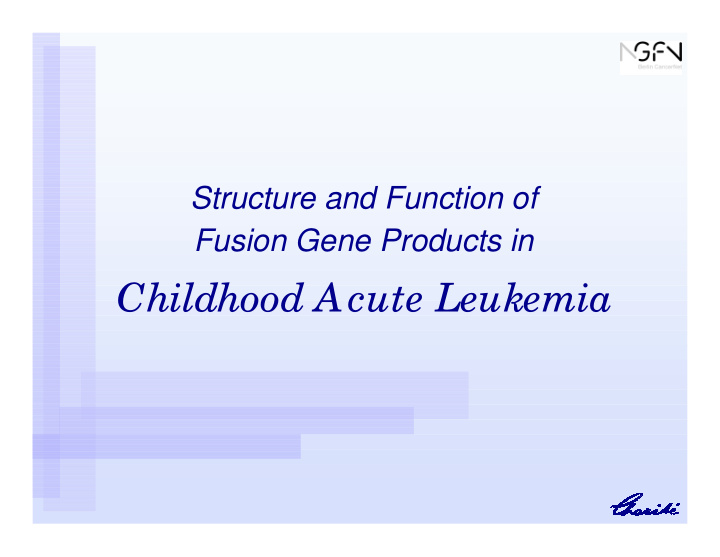



Structure and Function of Fusion Gene Products in Childhood Acute Leukemia
Chromosomal Translocations Chr. 12 Chr. 21 der(12) der(21)
Distribution A.T. Look, Science 278 (1997)
Childhood ALL • TEL-AML1 t(12;21) 20% • E2A-PBX1 t(1;19) 5% Transcription factors Transcription factors • MLL fusions 6% • BCR-ABL t(9;22) 4% MLL-AF4 t(4;11) BCR-ABL p190 60% MLL-AF9 t(1;11) BCR-ABL p210 40% MLL-ENL t(11;19) Protein kinases ~ 30 diff. translocation partners Transcription factor
Transcriptional Activation Histone Sequence-specific DNA-binding factor DNA Chromatin Co-Activator Histon Acetylation Complex
Transcriptional Activation Histon Acetylation Complex Chromatin Remodeling Exposed site Gene Transcription RNA Polymerase II
Transcriptional Repression Co-Repressor Histon Deacetylation Complex (HDAC) Chromatin Condensation and Gene Silencing
Combinatorial Control Transcription factors build up activating or repressing protein complexes Differential effects depending Cross talk between on molecular environment signaling pathways
TEL Synonym: ETV6 Ets-like transcription factor Widely expressed in all normal tissues, frequently lost in tumors Central Pointed N- ETS -C Dimerization Recruiting NCoR Protein interaction Recruiting Sin3A DNA-binding Histone Deacetylation Complex Transcriptional repression, gene silencing
AML1 Synonyms: RUNX1 / CBFA2 / PEB2 α B Gene family, homologous to Drosophila runt RHD TA N- -C dimerization transactivation DNA binding Co-repressors Co-activators CBFß Gene transcription: Myb Ets RHD TA + C/EBP e.g. Interleukin-3, GM-CSF, CSF1-R, TCRß, Myeloperoxidase Promotor
TEL-AML1 AML1 TEL Pointed Central -C RHD N- Deregulation of AML1 target genes HDAC mSin3 CBFß Enhanced Repression NcoR Myb Ets PNT RHD C/EBP TA + Promotor
Hematopoiesis
TEL-AML1 – WT AML1: necessary for hematopoiestic stem cells – TEL-AML1: generation of a pre-leukemic cellpopulation – Secondary genetic lesions necessary for transformation J. Zhu et al., Oncogene 21 (2002)
E2A A – bHLH transcription factor A Activation HLH – Regulates B-cell lineage genes, DNA-binding e.g. immunoglobulins, basic transcription factors EBF-1, Rag-1 – Regulator of lymphocyte differention
E2A-PBX1 • PBX1 • E2A-PBX1 – homologous to Drosophila A extradenticle ( exd ) A – normally not expressed in A lymphoid cells PBX – Cofactor for HOX proteins HD HD Meis 5‘-TGATTGAT-3‘ Hox genes activation A PBX – abberant Hox gene activation Homeodomain HD HD – Disturbance of lymphoid differentiation 5‘-TGATTGAT-3‘ – Promotion of uncontrolled cell division Hox genes activation repression
MLL Fusions • MLL gene – M ixed L ineage L eukemia – homologous to Drosophila trithorax ( trx ) • MLL fusions P. Ernst et al., Curr. Oppin. Hematol. 9 (2002)
MLL Function – maintanance of Hox gene expression – loss of MLL leads to severe developmental defects in mice – Role in hematopoiesis: downstream or parallel of GATA-2 J. Zhu et al., Oncogene 21 (2002)
Protein Kinases • Phosphorylation of serine & threonine or tyrosine residues – Serine-threonine kinases – Tyrosine kinases • Phosphorylation is a common mechanism to regulate protein activity • Protein phosphatases reverse the effects of protein kinases
Tyrosine Kinases • Receptor tyrosine kinases (membrane bound) • Non-receptor tyrosine kinases (cytoplasmic) e.g. Src family of kinases P Y SH3 SH2 Protein kinase Binds Binds Phosphorylated Inactive polyproline phosphotyrosine tyrosine kinase stretches
Signal transduction Cytokines (e.g. Interleukin, Interferon, CSFs, Erythropoietin) S.G. Rane et al., Oncogene 21 (2002)
BCR-ABL • BCR – Serine threonine kinase • ABL – Tyrosine kinase, non-receptor type – Distantly related to Src-kinases, ubiquitously expressed – Multifunctional kinase acting in different signaling pathways – Role in cell cycle progression, activation of apoptosis • BCR-ABL – Oncogenic transformation requires deregulated tyrosine kinase activity – Causes enhanced proliferation and prolonged viability of cells
BCR-ABL BCR ABL Not in p190 B. Scheijen et al., Oncogene 21 (2002)
Treatment Implications • Gleevec™ / STI-571 – Tyrosine kinase inhibitor, selective for Abl, c-Kit and PDGFR – Almost no side effects – Successful in treatment of CML – Occurrence of resistancy in acute leukemia • Ras pathway inhibitor – Successful in a murine model of ALL – Investigated in clinical trials
Recommend
More recommend